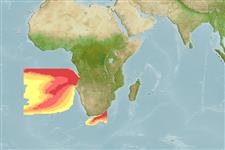>
Beloniformes (Needle fishes) >
Exocoetidae (Flyingfishes)
Etymology: Hirundichthys: latin, hirundo = swift; 1300 + Greek, ichthys = fish (Ref. 45335).
Environment: milieu / climate zone / depth range / distribution range
Ecología
marino; rango de profundidad 0 - ? m. Subtropical
Distribución
Países | Áreas FAO | Ecosistemas | Ocurrencias, apariciones | Point map | Introducciones | Faunafri
Circumglobal: Southern Hemisphere. Southeastern part of the area (most northern
record off Baia dos Tigres, Angola) (Ref. 109257); Ascension I. (Ref. 98447).
Tamaño / Peso / Age
Maturity: Lm ? range ? - ? cm
Max length : 27.0 cm SL macho / no sexado; (Ref. 109257)
Short description
Morfología | Morfometría
Radios blandos dorsales (total): 10-13; Radios blandos anales: 11 - 13; Vértebra: 44 - 47. This species is distinguished by the following characters: elongated body nearly rectangular in cross-section, almost flat ventrally, its depth 5.5-7.1 times in standard length (SL): vertebrae 44-47; predorsal scales 26-32; scales in transverse row 5.5-7.5, usually 6-6.5; head 4.5-5.1 times in SL: eye 2.8-3.0 times in head; subequal jaws conspicuous and conical teeth; no palatine teeth; gill rakers on first arch 25-32; low dorsal fin 10-13 rays; anal fin with 11-13 rays, originating slightly before, or 1-2 rays behind dorsal-fin origin; pectoral fins 1.2-1.4 times in SL, with 17-20 rays, first 2 rays unbranched; pelvic fins 2.7-3.5 in SL, inserted slightly nearer to posterior margin of opercle than origin of caudal-fin base; juveniles not barbelled; colour of body dark above and pale below, dorsal and caudal fins greyish, anal fin transparent, pectoral fins black without unpigmented cross-band and with a moderate light outer margin, pelvic fins without black spot; juveniles that are less than 10 cm are without vertical bands on body and with the dorsal, pectoral and pelvic fins not mottled with dark spots and bands (Ref. 109257).
Life cycle and mating behavior
Madurez | Reproducción | Puesta | Huevos | Fecundidad | Larva
Carpenter, K.E. and N. De Angelis (eds.), 2016. The living marine resources of the Eastern Central Atlantic. Vol. 3: Bony fishes part 1 (Elopiformes to Scorpaeniformes). FAO Species Identification Guide for Fishery Purposes, Rome, FAO. pp. 1511-2350. (Ref. 109257)
IUCN Red List Status (Ref. 130435)
Threat to humans
Harmless
Human uses
Más información
PaísesÁreas FAOEcosistemasOcurrencias, aparicionesIntroduccionesStocksEcologíaDietacomponentes alimenticiosconsumo de alimentoRación
Nombres comunesSinónimosMetabolismoDespredadoresEcotoxicologíaReproducciónMadurezPuestaAgregación para la puestaFecundidadHuevosEgg development
Age/SizeCrecimientoLength-weightLength-lengthLength-frequenciesMorfometríaMorfologíaLarvaDinámica larvariaReclutamientoAbundanciaBRUVS
ReferenciasAcuiculturaPerfil de acuiculturaRazasGenéticaElectrophoresesheritabilidadEnfermedadesProcesamientoNutrientsMass conversion
ColaboradoresImágenesStamps, Coins Misc.SonidosCiguateraVelocidadTipo de nataciónSuperficie branquialOtolitosCerebrosVisión
Herramientas
Special reports
Download XML
Fuentes de Internet
Estimates based on models
Phylogenetic diversity index (Ref.
82804): PD
50 = 0.5002 [Uniqueness, from 0.5 = low to 2.0 = high].
Bayesian length-weight: a=0.00646 (0.00292 - 0.01429), b=3.04 (2.84 - 3.24), in cm total length, based on LWR estimates for this (Sub)family-body shape (Ref.
93245).
Nivel trófico (Ref.
69278): 3.0 ±0.1 se; based on size and trophs of closest relatives
Resiliencia (Ref.
120179): Alto, población duplicada en un tiempo mínimo inferior a 15 meses (Preliminary K or Fecundity.).
Fishing Vulnerability (Ref.
59153): Low vulnerability (23 of 100).
